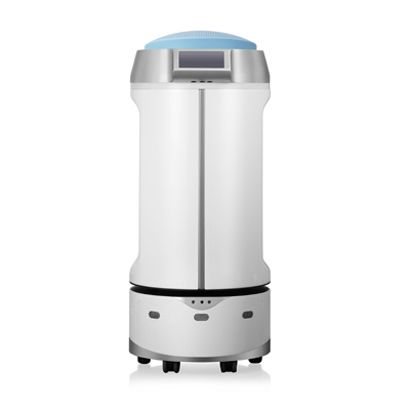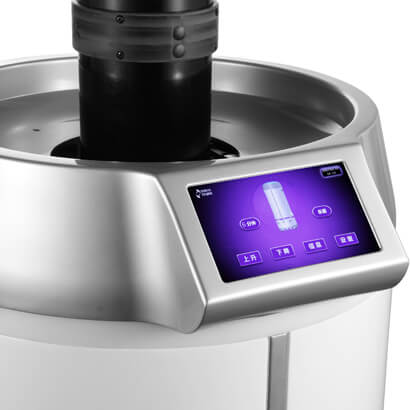What are the advantages of buying Xenon UVC Robot?
2022-03-01 by hqt
Xenon UVC Robot is used to disinfect all types of spaces and surfaces. Its most common application is in medical spaces like clinics and hospitals.
Xenon UVC Robot emits short-wave radiation at 200-315 nm to disinfect surface at the distance of 3 meters within 5 minutes. You can see these robots are quite effective and swift in terms of performing disinfection. Generally, hospitals use manual disinfection method and the most popular are chemical cleaning. This method has become old and is not much effective too. Furthermore, there are chances of chemical residues.
What advantages Xenon UVC Robot provide?
The biggest advantage of Xenon UVC Robot is its automation, and rapid technology to kill multiple deadly viruses. Similarly, you can use it anywhere in hospital or any other commercial place. It doesn’t leave any residue. Moreover, its disinfection speed is impressive too.
How does a tradition uv robot work?
The exposure time to kill germs in a room of a given size depends on the number of UVC lamps and the wattage of your UV bulb. Therefore, if we want the disinfection to be fast in a large room, it will be necessary to incorporate a greater number of lamps or with a more powerful UVC bulb. Furthermore, these robots are efficient against all major and minor viruses and bacteria.
Doneax Has Varity of disinfection robots according to your need
We have different disinfection robots to install in all types of spaces that need disinfection. Moreover, can offer the best professional solutions at prices adjusted to the needs of each client.
Major Industries that can buy Xenon UVC Robot
Xenon UVC Robot is especially best for highly compartmentalized spaces (such as hotels, aesthetic clinics, physiotherapy or dental clinics with several departments or boxes). Similarly, these robots are best for large premises with equipment that produces disinfection shadows. These are:
- gym with different exercise machines
- school classrooms,
- Theaters
They are portable and therefore allow different boxes or rooms to be disinfected. In addition, this mobility is also essential to disinfect shaded areas.
Features and Benefits:
Easy control: Smart control is an essential element to work with this type of Xenon UVC Robot. It works automatically.
Environment Protection: These robots do not leave any residue behind.
Safe Operations: Xenon UVC Robot does not harm any object in the hospital. It is quite safe and provides comprehensive results.
Xenon UVC Robot is the need of Contemporary Time
Advances in technology have made it possible to incorporate Xenon UVC Robot. Robots that emit germicidal ultraviolet light have become very popular coinciding with the expansion of Covid-19 in order to eliminate or reduce the presence of the SARS-Cov-2 Coronavirus in hospitals and clinics.
It is in this type of space and in large, highly compartmentalized facilities where the use of an ultraviolet robot acquires its greatest utility.
They are usually equipped with several UVC lamps to maximize their disinfecting power. They have a guidance system to move autonomously through all areas of the space to be disinfected.
Maximum capacity in sterilization and disinfection:
Xenon UVC Robot is indicated for large surfaces to be disinfected, they are designed with several high-power UVC ultraviolet lamps that disinfect air and surfaces of the areas they pass through very quickly.
Robot with autonomous movement: Autonomous robots are equipped with smart guidance systems that allow them to establish a map and disinfection routes.
Collision prevention system: They also have anti-collision systems and a presence detector to avoid accidents due to collision.
The robot drives over the room in the same way every time it is used without any deviation, thus ensuring consistent disinfection that can be validated. The risk of transmission of contagious hospital germs to patients and staff is thus reduced to a minimum.
Why uv light is best for disinfection in hospitals?
Ultraviolet light has a spectrum with different wavelengths; UV-C light is the shortest wave ultraviolet radiation and comprises the range of wavelengths between 200 and 315 nanometers. Ultraviolet light acquires the greatest germicidal power around the frequency of 315 nanometers, which is where Xenon UVC Robot developed for this purpose work.
When pathogenic organisms such as viruses and bacteria receive the appropriate dose of UV-C radiation, damage is produced to their DNA and RNA nucleic acids in such a way that the reproduction of pathogens and their ability to infect is prevented.
Uses of UV-C light emitted by Xenon UVC Robot
UV-C ultraviolet radiation has been used for more than 50 years thanks to its well-known germicidal and bactericidal effect. It has been used very successfully to combat tuberculosis (especially in air disinfection in rooms with infected people) and is currently being used in the fight against the Covid-19 pandemic caused by the SARS-CoV-2 coronavirus.
UV-C light is capable of eliminating (or deactivating) all kinds of pathogenic microorganisms such as viruses and bacteria in the air, water and surfaces.
One of the great advantages of Xenon UVC Robot is that it is a technology that does not use chemicals and therefore it is the only one that can be used in some spaces such as factories with food processing or spaces that require deep disinfection such as clinics and hospitals.
Xenon UVC Robot and Coronavirus SARS-CoV-2
There are several studies from universities and international laboratories that ensure that radiation with ultraviolet light rays deactivates the SARS-CoV-2 coronavirus, preventing its replication.
The fact that the corona virus can be effectively fought with this autonomously acting robot is good news, despite the corona vaccine that has now been developed, since the device has a preventive effect. This means that the corona viruses are rendered harmless before anyone can become infected with them.
Summary
The short-wave UV-C radiation with a wavelength of 315 nm is very energetic and kills viruses and bacteria by damaging their DNA. As a result, these pathogens are no longer viable and die off. UV-C radiation is also effective against the corona virus. UV-C radiation is therefore ideal for disinfecting surfaces contaminated with pathogens.



